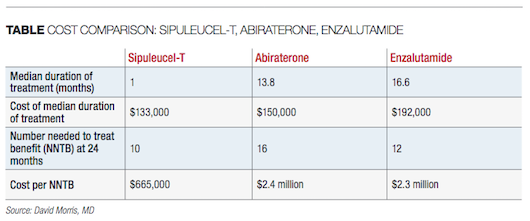Article
Sipuleucel-T cost lower vs. oral drugs over time
Author(s):
Analyses based on number needed to treat benefit show that the overall survival benefit is similar when using abiraterone acetate (ZYTIGA), enzalutamide (XTANDI), or sipuleucel-T (Provenge) to treat men with chemotherapy-naïve metastatic castration-resistant prostate cancer. The data, however, favor sipuleucel-T for having the lowest direct cost.
Analyses based on number needed to treat benefit (NNTB) show that the overall survival (OS) benefit is similar when using abiraterone acetate (ZYTIGA), enzalutamide (XTANDI), or sipuleucel-T (Provenge) to treat men with chemotherapy-naïve metastatic castration-resistant prostate cancer (mCRPC). The data, however, favor sipuleucel-T for having the lowest direct cost.
“There is no question that all three treatments for mCRPC are expensive and that sipuleucel-T carries the highest initial cost. However, the estimated total drug cost to achieve an additional patient OS benefit declines over time with sipuleucel-T whereas it increases for the oral drugs that are given as ongoing therapy,” said David Morris, MD, a urologist with Urology Associates, Nashville, TN, who presented the research at the AUA annual meeting in Chicago.
“NNTB represents the expected number of patients needed to be treated to prevent one additional death compared to placebo at a specified time point, and it is a useful and intuitive measure of OS that can be included in the shared decision-making process about initial treatment options for mCRPC,” Dr. Morris said. “Ultimately, treatment decisions should be individualized, taking into account side effect profiles, the physician’s experience, and the patient’s characteristics and preferences.”
Also see: PET use in prostate cancer widens, but questions remain
The analyses were performed using data from placebo-controlled pivotal trials investigating each of the treatments in men with chemotherapy-naïve mCRPC (COU-AA-302 for abiraterone, IMPACT for sipuleucel-T, and PREVAIL for enzalutamide). The NNTB values, which are calculated as the inverse of the absolute risk reduction, were derived from the studies’ Kaplan-Meier OS curves.
Costs for the oral drugs were taken from the 2019 Wholesale Acquisition Cost listed in the IBM Micromedex Red Book. The sipuleucel-T cost was based on the second quarter 2019 Medicare Part B payment and included both the leukapheresis and preparatory procedures needed for product manufacture.
For each of the oral drugs, the total drug cost at 24 months was calculated as the mathematical product of the monthly cost and its median treatment duration in the pivotal trial. For sipuleucel-T, the 24-month cost was based on the initial cost divided by 24 months. Cost per NNTB was calculated as the mathematical product of the drug cost, each NNTB value, and the duration of treatment.
The results showed that sipuleucel-T had the shortest median duration of treatment (1 month) followed by abiraterone (13.8 months) and enzalutamide (16.6 months). Cost of median duration of treatment for sipuleucel-T, abiraterone, and enzalutamide was approximately $133,000, $150,000, and $192,000, respectively.
The NNTB at 24 months was 10 for sipuleucel-T, 16 for abiraterone acetate, and 12 for enzalutamide, and the cost per NNTB for the three treatments was approximately $665,000, $2.4 million, and $2.3 million, respectively.
An NNTB calculation was also done for African-American men treated with sipuleucel-T with a result of 3 at 24 months.
“Survival outcomes for the subgroup of African-American men were not reported in the abiraterone and enzalutamide clinical trials. The NNTB values for sipuleucel-T show that its OS benefit was greater in African-American men than in the overall IMPACT population and suggest it is an effective therapy in African-American men,” said Dr. Morris.
Next: Cost analysis did not account for subsequent therapies
Cost analysis did not account for subsequent therapies
Dr. Morris pointed out that as a limitation, the cost analysis did not account for subsequent therapies used to treat prostate cancer after men failed on their assigned treatment.
“About 50% to 80% of men in the three studies experienced disease progression and went on to other treatments, but the treatments received by men differed across the three studies. The sipuleucel-T study was performed earlier than the oral drug trials, and men in that study who failed sipuleucel-T went on to chemotherapy, whereas subsequent treatment for men in the oral drug studies could have included one of the oral drugs or sipuleucel-T because they were already approved,” Dr. Morris explained.

“There is no way to estimate exactly what the added cost would be to achieve the survival curves that represent treatment with initial and subsequent therapy.”
Read: Class effect is good news for men with nonmetastatic CRPC
Dr. Morris also noted that the cost analysis does not include the indirect costs of treatment incurred because of monitoring visits or resulting from management of side effects.
“An ongoing analysis is trying to determine those additional costs using adverse event data from the pivotal trials,” Dr. Morris told Urology Times.
“We expect that the indirect costs will be lowest for sipuleucel-T because compared with either of the oral drugs, it tends to be associated with a lower rate of side effects that may require hospitalization or other intervention,” he added.
The research was sponsored by Dendreon. Dr. Morris is a consultant to Dendreon, Astellas/Pfizer, and Janssen.














